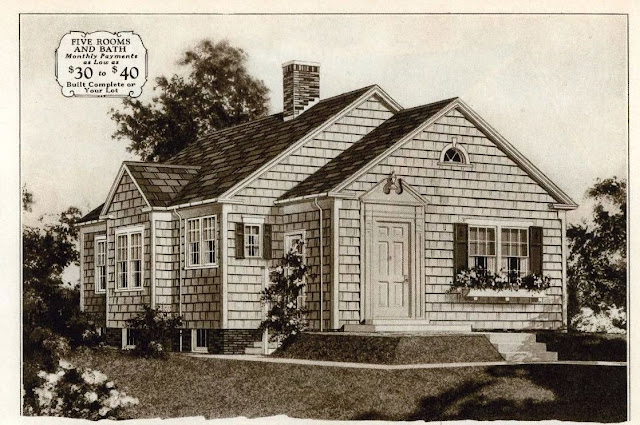 |
| The Sears Melrose. Price (if financed through Sears Roebuck) $30 to $40 per month. Sounds good to me! |
It's a Colonial bungalow, with a formal pediment around the front door. There is a lunette window above. As was typical for Sears, they took a basic bungalow and added elements that made the house very attractive to buyers.
So... where are the houses in the Chicago area? There's one in the south suburbs and one in the north suburbs.
Calumet City
 |
| 1437 Kenilworth Ave Calumet City, located by Andrew Mutch. Capture from Google Streetview. |
This Melrose in Calumet City has had some minor changes, but the basement door adjacent to the front door is the dead giveaway.
Libertyville
 |
| 220 Appley, Libertyville. This Melrose has been reversed. Photo from Realtor site. |
 |
| The windows for the two rear bedrooms. Photo from Realtor site. |
 |
| The living room, with the front vestibule on the left side. Photo from Realtor site. |
 |
| Photo from Realtor site. |
 |
| Swinging door from the dining room to the kitchen. Photo from Realtor site. |
 |
| The kitchen. That tiny window faces the front of the house. Photo from Realtor site. |
 |
| Photo from Realtor site. |
 |
| Photo from Realtor site. |
 |
| Photo from Realtor site. |
This Melrose is authenticated. In April 1931, Henry M. Mesenbrink got a mortgage from Sears Roebuck for $3,700. Henry worked for the Foulds Milling Co in Libertyville, which made macaroni, spaghetti and noodles.
 |
| The Foulds plant. Photo from the Libertyville-Mundelein Historical Society. |



1 comment:
The kitchen location is not only unusual for a Sears design, but unusual for the era, as well. The secondary door, though just a few feet from the front door, effectively serves as the "back" or service door. Very handy for hauling groceries, etc., into the house if you don't an attached garage or alley access. This one appears to have survived with its interior largely intact!
Post a Comment